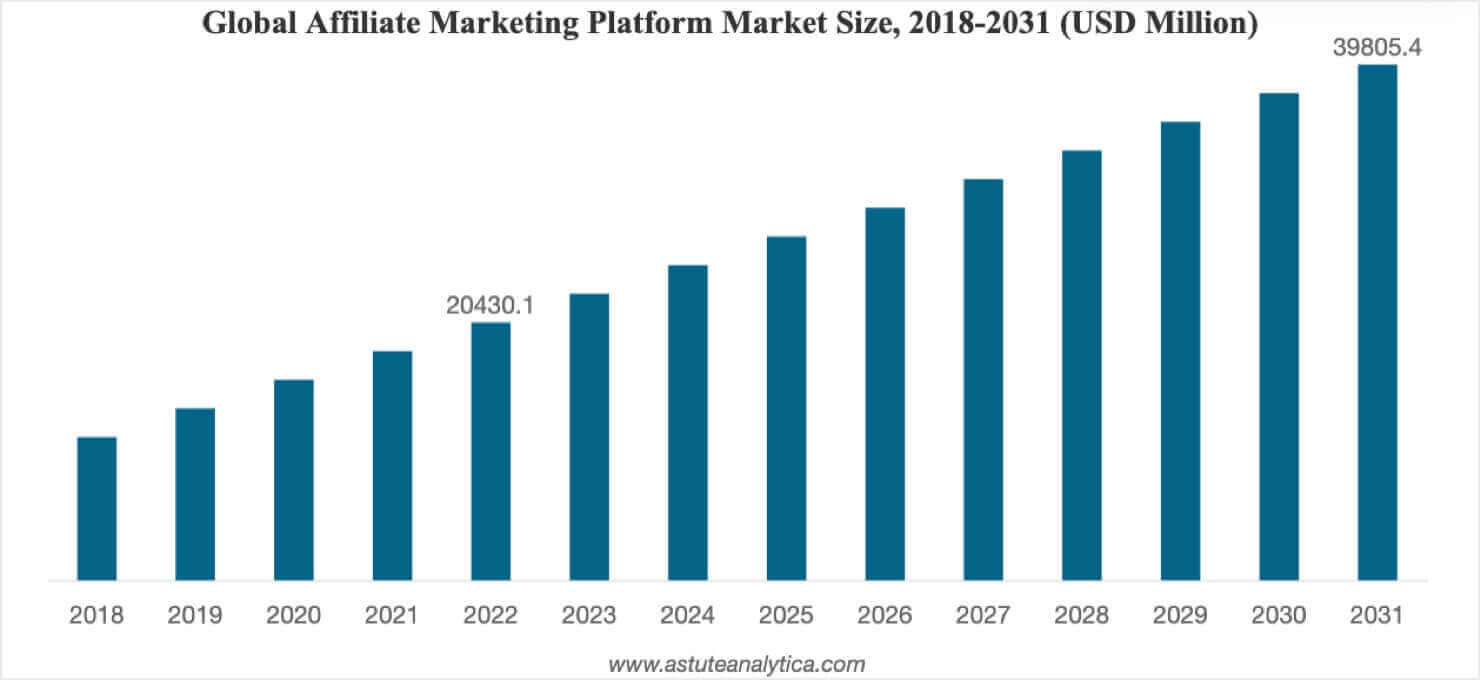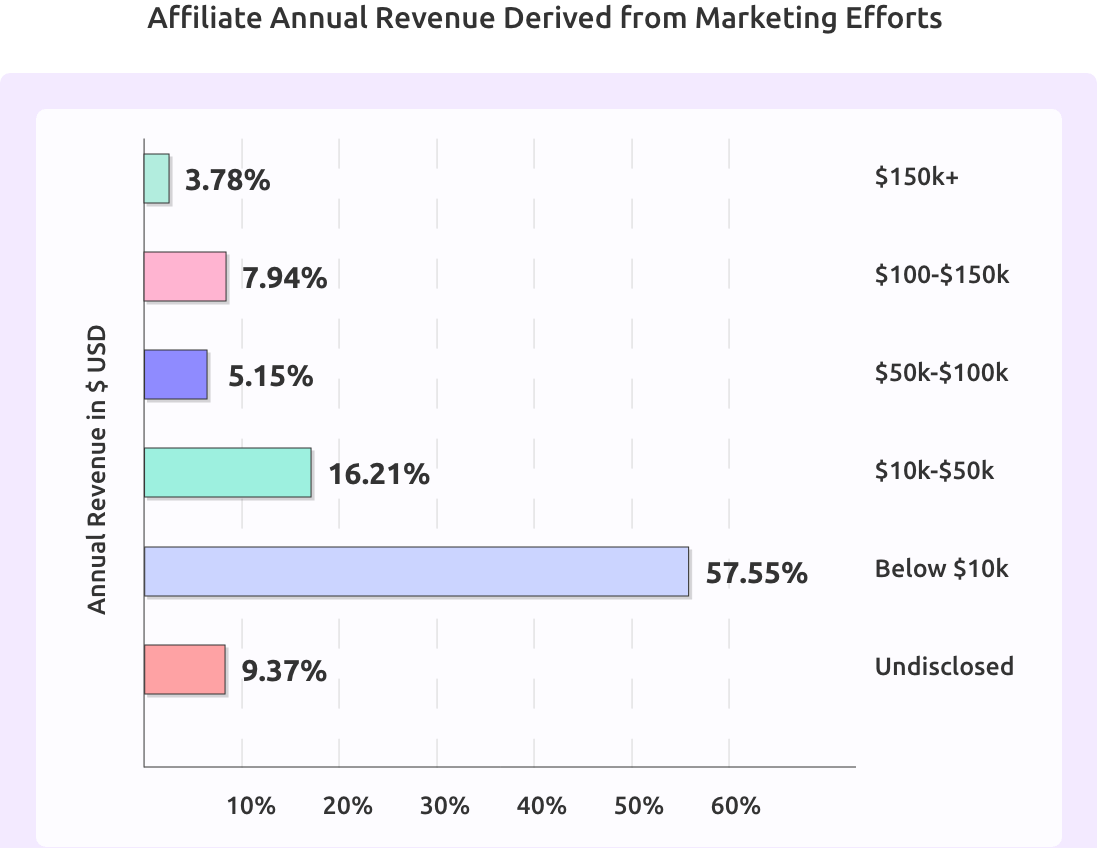Shocking Truth: How Much Commission Does an Affiliate Really Make?

Have you ever thought about starting an affiliate marketing business and making it a serious source of income? You might be surprised just how big this opportunity really is.
Let’s talk numbers: over 80% of brands worldwide are tapping into affiliate marketing to grow their sales. It’s not just a side hustle for companies, but it has become a major player in the business world.
This isn’t some small corner of the internet either. The affiliate marketing industry is worth a staggering $12 billion globally and continues to grow by around 10% every year. That’s not just growth; that’s an unstoppable trend!

Here’s something else that might blow your mind: affiliate marketing is responsible for 15% of all digital media revenue. That means for every dollar spent online in this space, a chunk of it is being earned by affiliates.
And when you look at e-commerce in the U.S., 16% of online sales come from affiliate marketing. Think about that. Nearly one in every six purchases owes its existence to affiliates doing their thing.
So, why is this such a big deal? Because it shows that affiliate marketing isn’t just a passing trend, it’s a foundational part of online shopping and digital advertising. It’s become a go-to strategy for brands looking to expand their reach and for affiliates looking to generate serious income.
But here’s the real question everyone’s asking: How Much Commission Does an Affiliate Really Make? Is it just pocket change, or are there people out there turning this into life-changing money? In this article, we’re going to break it all down. We’ll dive into how affiliate commissions work, what the numbers really look like, and even share some real-life success stories.
By the time you’re done reading, you’ll not only understand how affiliate commissions are calculated, but you’ll also have a clear picture of what’s possible in this exciting space. Whether you’re curious about a side hustle or dreaming of a full-time gig, this deep dive into affiliate earnings will show you the potential that’s waiting for you.
Key Takeaways
- Did you know that over 80% of brands rely on affiliate marketing? That alone says a lot about how powerful and effective it is.
- This industry is no small fry; it’s worth around $12 billion and still growing steadily every year.
- Affiliate marketing isn’t just a side hustle; it’s responsible for 15% of all digital media revenue. That’s huge when you think about the big picture of online business.
- Knowing how much you can potentially earn helps you set realistic goals. It’s about turning ambition into action, one step at a time.
- The success stories: real people are making serious money in affiliate marketing. It’s proof that with the right approach, the earning potential is there for you too.
Understanding Affiliate Marketing Basics
Affiliate marketing is pretty straightforward: you promote a product, and when someone buys through your affiliate link, you earn a commission. Simple, right? But don’t let that simplicity fool you; this system plays a very significant role in online shopping. It’s a key part of digital marketing, seamlessly connecting affiliates, merchants, and customers in a win-win partnership.
One of the reasons companies love affiliate marketing is its performance-based nature. They only pay when affiliates deliver results, like sales or leads. It’s efficient and cost-effective.
Discover “Affiliate Marketing for Beginners: From Side Hustle to Financial Freedom in 10 Simple Steps“. This guide simplifies affiliate marketing, helping you build a profitable business and achieve financial independence. Get your copy today.
How Does Affiliate Get Paid?
Now, let’s talk about how affiliates get paid. There are a few common models:
- Pay per sale: You earn a percentage of each sale made through your link.
- Pay per lead: You’re paid when someone completes an action, like filling out a form or signing up for a newsletter.
- Pay per click: You make money by driving traffic to a merchant’s site, regardless of whether they buy something or not.
- Cost-per-acquisition (CPA): You get paid for each lead or customer acquired through your efforts.
These days, most programs focus on rewarding actual sales or leads rather than just clicks, ensuring better results for everyone involved. Unsurprisingly, about 79% of online companies use affiliate marketing to expand their reach.
Not all affiliates are the same, though. Some promote products they’ve never used, while others personally test and endorse what they’re selling. The latter approach tends to build much stronger trust with audiences and drives better results.
For digital entrepreneurs, affiliate marketing is one of the most effective ways to make money online. It’s a smart mix of analytics, creativity, and marketing that helps businesses grow while giving affiliates the chance to earn real income.
In summary:
| Commission Structure | Definition |
|---|---|
| Pay per sale | Affiliates earn a percentage of the product price. |
| Pay per lead | Affiliates are compensated for consumer actions like forms and sign-ups. |
| Pay per click | Affiliates get paid for traffic directed to merchant sites. |
| Cost-per-acquisition (CPA) | Earnings for each lead obtained via an affiliate link. |
How Much Commission Does an Affiliate Really Make
While affiliate marketing presents huge earning opportunities affiliates receive varying income levels based on multiple influencing aspects.
According to Glassdoor, the average annual salary for an affiliate marketer is $59,060, with total earnings ranging from $58,000 to $158,000. This includes additional compensation options such as commissions, cash bonuses, tips, or profit-sharing.
The earnings potential for affiliates depends on promotional products along with sales strategies and personal experience level.
Therefore, prospective affiliate marketers need to evaluate earning outcomes properly because doing so establishes sensible goals and directs your affiliate marketing business development trajectory.

Affiliate Earnings Breakdown: What to Expect at Different Levels
Affiliate marketing income varies significantly based on experience, marketing tactics, and niche. Here’s a more relatable breakdown to give you a clearer idea of what you could earn at each stage:
1. Beginner ($0 to $1,000 per month)
When starting, you’re mostly focused on learning the ropes. You might create content, test strategies, and figure out what resonates with your audience.
As a beginner, you’ll likely work with products that have lower price points, and you may start with well-known programs like Amazon Associates.
- Example: Suppose you sell a $25 product that offers you a 4% commission fee. When you reach your first-month sales target of 100 products, you will earn a total of $100.
- Inspiration: Many bloggers start their affiliate journey by writing product reviews or creating “best-of” lists. Your first few months might feel slow, but this is where you build the skills and confidence to grow.
2. Intermediate ($1,000 to $10,000 per month)
As you gain experience and learn what works, you can start scaling your efforts. At this point, affiliates often use a combination of SEO, email marketing, and social media ads to reach a larger audience.
You might also shift towards promoting higher-ticket items or recurring products that bring in regular commissions.
- Example: If you’re promoting a $50 SaaS product with a 20% commission, each sale brings you $10. If you close 100 sales, that’s $1,000 in passive income each month.
- Inspiration: Affiliates in niches like personal finance or tech often thrive at this level, recommending tools, credit cards, or services to a highly engaged audience.
3. Advanced ($10,000 to $100,000 per month)
Affiliates operating at this tier have perfected their system operations while optimizing their traffic sources and they often choose partnerships with exclusive or high-ticket programs. Affiliates with these earnings harness paid ad strategies and major marketing programs for substantial progress.
- Example: Selling a $1,000 digital course with a 30% commission would earn you $300 per sale. If you close 100 sales, that’s $30,000 in a month.
- Inspiration: Successful affiliates like John Crestani have built empires by using paid ads and high-ticket offers to generate massive returns.
4. Super Affiliate (Over $100,000 per month)
Super affiliates represent an elite category that sets them apart from other marketing professionals. Super affiliates take control over niche markets through exclusive business partnerships while they lead digital marketing teams and launch product lines. Their sophisticated methods enable them to achieve maximum scaling results.
- Example: If you’re promoting a $500 coaching program and earn a 10% commission, each sale brings in $50. If you refer 300 people, you’ll make $150,000.
- Inspiration: Pat Flynn, the founder of Smart Passive Income, has become a super affiliate by promoting products he believes in, leveraging his large following, and scaling his content through podcasts and videos.
Different Ways Affiliates Earn
The affiliate earning structure changes depending on the payment system defined by their respective program. Here are the most common models:
1. Pay-Per-Sale
Affiliates make gains by receiving a defined percentage from product sales they successfully help sell.
For instance, with a 15% commission rate affiliates receive $30 from each $200 product sale. Selling 200 products each month results in earning $6,000.
2. Pay-Per-Lead
Through this affiliate model, businesses give incentives to affiliates who help users complete particular actions which may include signing up for free trials or completing registration forms.
For example, when a program offers $20 per lead you create 100 leads in one month to earn $2,000.
3. Recurring Commissions
This model is often used with subscription-based products, like SaaS services, where you continue to earn commission as long as the customer stays subscribed.
For example, if you refer 50 customers to a $50/month service with a 20% commission, you’ll earn $500 each month from those referrals.
4. High-Ticket Sales
With high-ticket items, you earn a larger commission per sale because the product or service is more expensive.
For example, affiliates receive $200 for each successful sale through the promotion of a coaching program priced at $2,000 with a 10% commission rate. Sell 50 courses, and you’re at $10,000.
5. Flat-Rate Payments
Business partners benefit from static earnings whenever an action or conversion happens which remains the same across different product prices.
For instance, affiliate marketers earn $5,000 from successfully driving 50 sign-ups for a program that pays $100 each time.
Here Are Some of The Real Stories to Inspire You
- Michelle Schroeder-Gardner (Making Sense of Cents):
Michelle generates more than $50,000 monthly via affiliate marketing by endorsing financial tools and blogging education programs. She succeeds by developing genuine, beneficial content which connects with her audience. - Tom Dupuis (Online Media Mastery):
Through his WordPress hosting service promotions, Tom generates monthly earnings of over $10,000. The author of detailed on-page SEO best practice reviews emerged as a trusted expert in his field. - Spencer Mecham (Buildapreneur):
By selling expensive affiliate products Spencer achieves a six-figure income each month. He applies YouTube campaigns and email marketing strategies to achieve better reach together with higher conversion rates.
Through affiliate marketing, you can earn money from multiple sources that boost your potential income while sending better performance with improved strategies. From promoting basic consumer goods you are building your foundation through understanding commission breaks while sticking with your chosen method and never stopping learning.
Common Myths About Affiliate Commissions
In the world of affiliate marketing, many myths can confuse people. Some think it’s a quick way to make money. But, it’s not true. The industry is growing fast, but making money takes time and effort.
Another myth is that you need to be tech-savvy to succeed. But, you can start with just $100 to $500 for basic things like a domain and hosting. (Just like I started with only $34) What’s important is your dedication and how well you promote, not your technical skills.
- Many believe affiliate commissions are always high; but, most affiliates make between 5% to 30% on sales.
- Some think affiliate marketing is only for big companies. But, over 80% of brands, big or small, use it for growth.
- Others think all affiliates make a lot of money. But, the average makes about $20,000 a year, with the top earners making over $150,000.
Over 90% of affiliates state they are satisfied with their affiliate marketing programs, indicating the potential for long-term partnerships.
Understanding the truth about affiliate commissions can help you succeed. By knowing the real deal, you can set realistic goals. As the digital world keeps changing, those who clear up these myths will likely find success.
| Myth | Reality |
|---|---|
| Get-rich-quick scheme | Geared towards long-term dedication and strategy |
| Requires technical expertise | Focus on promotion and strategic outreach, not technical skills |
| All affiliates earn high commissions | Commission rates vary; most earn 5% to 30% of sales |
| Only major brands benefit | Over 80% of all brands utilize affiliate marketing |
It’s crucial to know these myths to make effective strategies. As you explore affiliate opportunities, remember these facts.
How to Calculate Your Affiliate Income
Figuring out your affiliate income needs a careful plan. Start by looking at your website traffic, how many people buy from you, and the pay from the programs you join. In 2023, half of US marketers used affiliate marketing at some point. Knowing how your audience acts is key to predicting how many will buy, which can change based on your field and marketing.
To get a clear picture of your earnings, try these steps:
- Traffic Volume: Check how many people visit your site. For example, if 3,000 people visit your blog every day, you can easily guess your earnings.
- Conversion Rates: Find out how many visitors buy something. Rates usually range from 1% to 5%, but some niches can do better.
- Commission Structures: Learn about the pay for the products you promote. Rates are usually between 5% and 30%, depending on the field. Some programs pay a flat rate or more for certain items.
Let’s look at a simple example to show how to guess your earnings:
| Metrics | Values |
|---|---|
| Daily Visitors | 3,000 |
| Conversion Rate | 2% |
| Average Order Value | $50 |
| Commission Rate | 10% |
| Estimated Earnings per Day | $300 |
In this example, earnings are figured out: 3,000 visitors x 2% conversion rate = 60 sales. Then, 60 sales x $50 average order x 10% commission = $300 daily. Remember, ongoing commissions can greatly boost your income over time.
Strategies for Increasing Affiliate Commissions
Boosting your affiliate commissions goes beyond increasing your work hours since success depends mainly on applying smart strategies.
Begin your efforts with superior merchandise that shows relevance and appeal to your target market. Promote products or services that solve customer problems and improve their way of living. Building authentic and valuable recommendations results in increased trust among your audience, leading to a rise in automatic conversion success.
Your audience reach needs multiple methods to perform successfully. Create SEO-rich website texts to pull in organic web visitors, engage your audience through social media platforms, and build thorough email marketing dispatches to maintain lasting connections.
By merging these tactics, you expand your audience size and build your reputation as an authority figure within your specialization. Delivering greater value to your audience increases the likelihood of activating opportunities through your affiliate links.
Choose the best affiliate programs that deliver ongoing incomes or multiple commission stages. Through these models, you can keep aligning your work with standard performance targets and increase your earnings after every period.
You need to remain result-focused while staying updated about your industry because strategy evaluation allows you to optimize your performance. Implementing appropriate effort along with expert knowledge and genuine authenticity helps you secure continuous commissions and uphold trust with your audience.
Challenges Faced by Affiliate Marketers
Honestly, affiliate marketing is no walk in the park. Sure, the potential to make money is exciting, but it’s not all passive income and overnight success.
For most people starting, the earnings are modest, and you have to put in the work before you see any real results. I remember when I first started; spending hours creating content, only to earn just enough to buy coffee. But as you learn the ropes and connect with your audience, things start to shift. You grow, your skills improve, and your income follows.
The competition, though? Oh, it’s fierce. You’ve got thousands of affiliates fighting for the same audience, often promoting similar products. And let’s not even talk about those high-ticket items. Yes, they come with hefty commissions, but promoting them takes serious effort. It’s not just about slapping up a link, but about creating content that convinces someone to trust you and make a purchase. That takes time, research, and a lot of trial and error.
Another challenge? Keeping up with this ever-changing digital world. Trends shift constantly, what worked last year might not work today. You’ve got to stay on top of things, whether that’s adjusting your SEO strategy or jumping on a new social platform.
It’s exhausting, honestly. Don’t ignore the spammy tactics some marketers use. While it might work short-term, it’s a surefire way to tank your credibility. The truth is, that success in affiliate marketing comes down to trust.
Build real connections with your audience, choose products that genuinely help them, and market in a way that feels authentic. That’s how you overcome the hurdles and, hopefully, build something sustainable.
Passive Income from Affiliate Marketing
Let’s talk about one of the most enticing parts of affiliate marketing: passive income. It seems like an idle dream when you think about making money without waking up. The truth is affiliate marketing demands more involvement than the “set-it-alone-wait-for-everything-to-work-by-itself” idea some people advertise.
A functional income-generating system requires time, along with effort to perfect through trial and error. Achieving success in this domain leads to fantastic benefits. Build a blog post or create a YouTube video today that allows you to earn revenue for years beyond its publication date.
The true magic behind affiliate marketing exists because it continues to generate revenue for you even after you finish your starting setup tasks.
The Long-Term Potential
Now here’s the thing: Affiliate marketing requires length sustained endurance instead of a fast race. Most affiliate marketers start their journey earning close to nothing but occasionally make a dollar or two.
I analyzed my affiliate dashboard countless times hoping to notice a modest $10 payout. Building an online presence combined with strategic refinement will result in substantial growth of those numbers.
Online marketers who gain momentum can generate earnings between $1,000 and $10,000 a month while top-performing affiliates reach monthly sales figures above $100,000.
There will be no shortcuts or fast success. Most affiliates require approximately two years of steady work to achieve earnings sufficient to replace their standard salaried pay.
Patience and Persistence Pay Off
I came to learn that patience is your best friend in this game. Success doesn’t happen overnight. Developing an audience demands time before you can build the necessary trust and create solid partnerships with affiliate programs.
Behold transformative life benefits once you complete your active dedication. Building value creation into your efforts enables you to achieve success through helpful blog posts and honest product reviews together with engaging social media content.
Through early investment of time and continuous maintenance, affiliate marketing systems will transform into enduring passive revenue sources that generate benefits for many years.
Conclusion
As we conclude, it’s clear that the affiliate marketing field is full of chances to make money. But it’s not just about numbers. Success in affiliate marketing boils down to strategy and understanding your commission structure. Whether commissions hit 10% or soar past 20%, picking the right niche and approach can make or break your efforts.
The earning potential varies wildly: while many affiliates make less than $10,000 a year, there’s a small, determined group pulling in over $150,000 annually. That gap highlights the importance of thoughtful planning, diversifying your efforts, and continuously honing your craft.
For beginners, the good news is that most affiliate programs offer tools and resources to help you hit the ground running, even without a marketing background. And let’s not forget one of the biggest perks of this industry is that you can work from anywhere.
With determination, a strong plan, and the right knowledge, you could turn affiliate marketing into your success story. Only about 4% of affiliates reach the top, but with hard work, there’s no reason you can’t be one of them.
So take what you’ve learned, start small, stay consistent, and build your path to financial freedom through affiliate marketing.
Frequently Asked Questions
How much can a beginner affiliate marketer expect to earn?
Starting, most beginners earn between $0 and $1,000 per month. It’s all about learning the ropes: building an audience, experimenting with marketing strategies, and figuring out which niches work best. Don’t expect overnight success, but focus on laying a solid foundation.
What factors determine how much commission affiliates earn?
Several factors influence affiliate earnings, including the niche, the type of affiliate program (percentage-based, flat-rate, or recurring), the commission rate, and the affiliate’s expertise. High-demand niches like finance or SaaS often offer higher commission rates, while affiliates with strong content and an engaged audience tend to earn more.
What’s the difference in commission rates across various programs?
Commission rates can vary widely. For instance, Amazon Associates might offer a 4% to 10% rate, while SaaS programs can range from 15% to 40%. Some luxury goods or high-ticket programs even offer commissions as high as 80%. Knowing which programs align with your niche is key to maximizing earnings.
Can affiliates earn a full-time income?
Absolutely! Many affiliates make a full-time living from affiliate marketing. Intermediate affiliates can earn between $1,000 and $10,000 monthly, while advanced marketers may rake in $10,000 to $100,000 or more. With dedication, strategic planning, and scaling efforts, it’s possible to replace or even surpass traditional income streams.
What’s the earning potential for super affiliates?
Super affiliates, who operate at the highest level, often earn over $100,000 per month. These marketers typically dominate niche markets, leverage high-ticket programs, and use advanced strategies like paid ads and email funnels to scale their earnings significantly.
Are there real success stories of affiliates making significant commissions?
Yes! For example, Pat Flynn of Smart Passive Income has shared how he earns six figures monthly through affiliate marketing by promoting tools and resources his audience trusts. Similarly, Michelle Schroeder-Gardner from Making Sense of Cents earns over $50,000 a month by promoting finance-related products. These stories highlight the potential when you pair the right strategies with hard work.







Practical advice, always appreciate posts that simplify the process! A free resource on Amazon launch strategies (including sourcing and avoiding common errors) could add value to readers. This may help many people.
Thank you